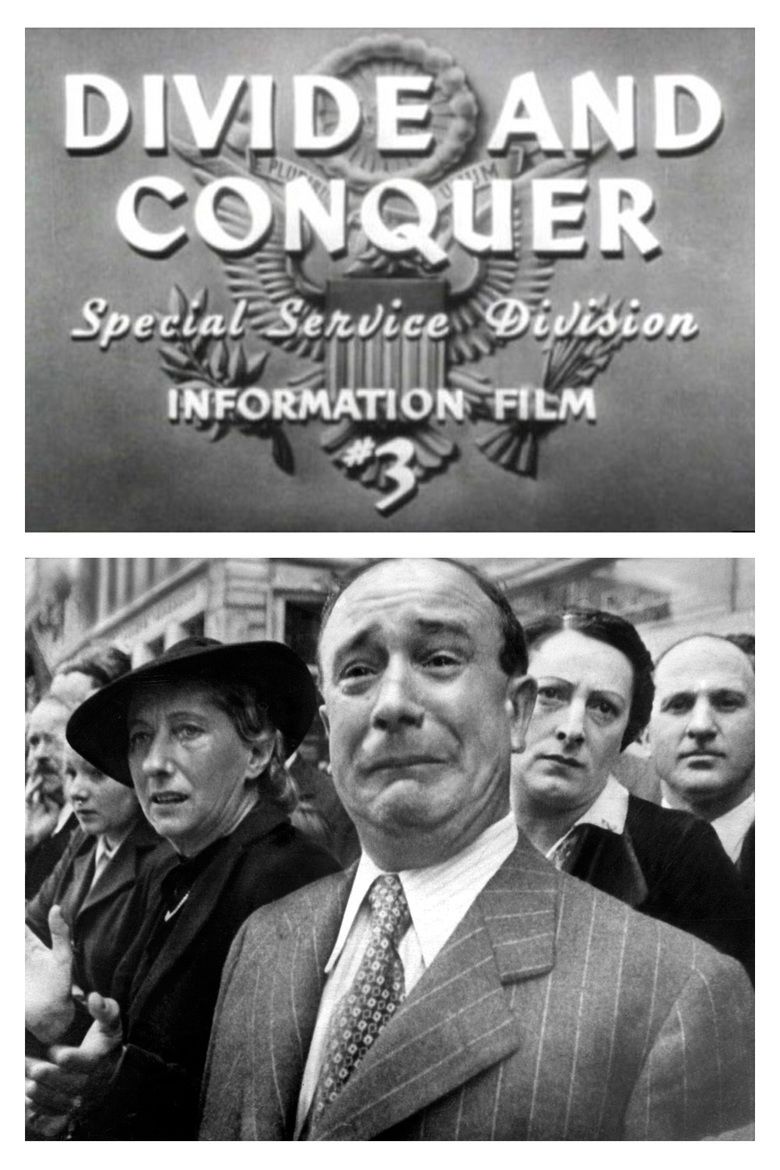Divide and Conquer (film)
7.2 /10 1 Votes7.2
7.2/10 Letterboxd Genre Documentary, History, War Duration Country United States | 7.4/10 IMDb Film series Why We Fight Language English | |||||||||||||||||||||||||||||||||
 | ||||||||||||||||||||||||||||||||||
Director Frank CapraAnatole Litvak Release date 1943 Music director Robert J. Flaherty, Arthur L. Todd Cast Knox Manning (Narrator), Murray Alper (Bit Role), General Bergeret (Himself - in Railway Carriage with Huntziger (archive footage)), Monte Blue (Bit Role), Karl Brandt (Himself (with jubilant Hitler, to his right) (archive footage)), Maurice Brierre (Bit Role)Similar movies Why We Fight movies, Related Frank Capra movies | ||||||||||||||||||||||||||||||||||
03 why we fight divide and conquer ca 1943 3 6
Divide and Conquer (1943) is the third film of Frank Capra's Why We Fight propaganda film series, dealing with the Nazi conquest of Western Europe in 1940.
The film begins immediately after the fall of Poland. Of the two major Western Allies of 1940, the United Kingdom is first to be mentioned. The role of the Royal Navy in blockading Germany is highlighted, in that it means that Germany must overcome British resistance in order to clear the way for its world conquest.
Hitler's treachery towards the small neutral countries of Europe is exposed - to Denmark: "We have concluded a non-aggression pact with Denmark" - to Norway: "Germany never had any quarrel with the Northern States and has none today" - to the Netherlands: "The new Reich has always endeavored to maintain the traditional friendship with Holland" - and to Belgium: "The Reich has put forth no claim which may in any way be regarded as a threat to Belgium". These quotes are repeated after the conquest of each of these countries is shown.
The first targets of the Nazis in 1940 were Denmark and Norway. Nazi interest in Norway is described in terms of Germany's desire to use Norway's fjords as U-boat bases, and to use airfields in Norway for a bomber attack on the British naval base at Scapa Flow. After Hitler's surprise invasion of Denmark is briefly mentioned, the film accuses the Nazis of using Trojan Horse ships - designed to look like merchant ships but concealing troops, tanks and artillery guns - as a way of seizing control of all of Norway's ports. The role of Norwegian traitors such as Vidkun Quisling in aiding the Nazi conquest of Norway is also emphasized. At the end of the section on Norway, Hitler is likened to gangster John Dillinger and Nazi-occupied Norway is portrayed as the northern claw of a giant pincer movement aimed against Britain. The conquest of France would provide the southern claw.
The film's story of France begins in 1914 at the Battle of the Marne. The offensive-minded spirit of French general Ferdinand Foch is emphasized: "My right is driven in, my center is giving way, the situation is excellent, I attack!" (the original in French is displayed on-screen). The film then goes on to describe the defensive orientation of 1930s France, exemplified by the Maginot Line. This is explained as being primarily due to the 6 million casualties which France suffered in World War I, but also due to factors including Nazi fifth column activities, political corruption and greedy vested interests.
Possible routes for a German invasion of France are discussed: the 1870 attack through Alsace-Lorraine and the 1914 attack through Belgium. The French, believing the Maginot Line impregnable, expect the German attack to come through Belgium, as in 1914. The French order of battle in 1940 is described: 78 divisions along the border with Belgium, 15 in the Maginot Line, 10 divisions facing Benito Mussolini's forces in Italy and 3½ divisions as a safeguard against Spain. The British Expeditionary Force contributed an additional 10 divisions.
The important role of paratroopers in the conquest of the Netherlands is covered, as is the fact that the Germans easily defeated Belgian resistance at Fort Eben-Emael knowing the best method of attack after extensive practice on an exact copy of the fortress built in occupied Czechoslovakia. Special attention is also paid to Nazi atrocities, such as the Rotterdam Blitz after the surrender of the city and Nazi attacks on villages and small towns (designed to choke roads with refugees and thus impede the Allied troop movements).
It is then mentioned that the Nazis' attack on Belgium and the Netherlands was a feint to distract from the main attack through the Ardennes, where the Allies least expected it. A U.S. military officer shows an animation which demonstrates the German blitzkrieg technique - tanks form the front spearhead, while infantry spill off from the sides to form solid walls, thus protecting the center of the column through which trucks pass to supply all forces involved.
References
Divide and Conquer (film) WikipediaDivide and Conquer (newsreel) IMDbDivide and Conquer (newsreel) LetterboxdDivide and Conquer (film) themoviedb.org
